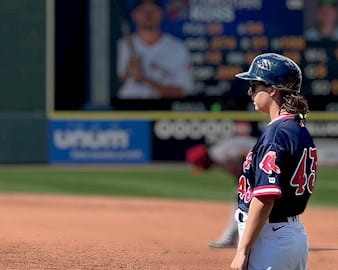
The Measure of Real Wealth
Inspired by his mother’s entrepreneurial spirit, Jason Brown, ’09, founded four successful companies by the age of 35, including the revolutionary fintech app Tally.
The Measure of Real Wealth
In 2020, Kim Ng, AB ’90, made headlines when she became the first woman ever named general manager of a Major League Baseball team. A University of Chicago softball captain who wrote her thesis on Title IX, she rose through the ranks from Chicago White Sox intern to MLB’s senior vice president for baseball operations before becoming the general manager of the Miami Marlins.
She told UChicago Magazine in 2018 that when she started, she knew analytics would be part of the gig—but “I didn’t quite understand how the smallest piece of data was going to factor into decisions at game time and on the talent-evaluation level.”
America’s national pastime has gone through a business revolution in the past 20 years. The 2003 publication of Michael Lewis’s Moneyball: The Art of Winning an Unfair Game opened the floodgates on using data analysis to better excel at the game. MLB teams needed people who could combine quantitative frameworks and strategic thinking to give their roster an edge.
In short, they needed people with the exact kind of skill set that Chicago Booth champions. A veritable dream team of Booth alumni are helping transform the sport. Michael Girsch, ’03, of the St. Louis Cardinals; Zach Aldrich, ’19, of the Pittsburgh Pirates; Vince Gennaro, ’77, of NYU; and Katie Krall, ’22, formerly of the Boston Red Sox, are all using data to make the game increasingly competitive—whether by picking the best players for the draft, executing trades, or adjusting players’ swings and pitches to psych out the competition.
Vice President and General Manager
St. Louis Cardinals
Working at Boston Consulting Group, Michael Girsch, ’03, couldn’t quite let go of the thought of breaking into his first love—baseball. The problem was, he had no experience.
After he and his wife had their first child, he found himself with plenty of sleepless nights. Chicago raised, as a teenager Girsch had developed an obsession with fantasy baseball, teaching himself Excel to draft elaborate spreadsheets to manage his fantasy teams. He stayed up now developing a new model for determining the value of a draft pick.
He sent a paper based on his model to the front offices of all major-league teams. His model took players’ signing bonus—the amount they’re paid when first drafted onto a team—and calculated how much they would be worth on the open market as free agents, using a metric that’s important to fans: the number of wins the players added to a season. Comparing the two showed how much a player was overvalued or undervalued, allowing teams to track the worth of their investments.
Within a few months of sending out his paper, Girsch was interviewing for an entry-level job with the St. Louis Cardinals.
Girsch, now vice president and general manager of the club, is widely credited as a pioneer in applying advanced data analytics to baseball, coming up with techniques that have become widespread throughout the industry. “My contribution has been bringing data to questions that no one thought data could help answer,” he says.

When he initially joined the Cardinals as a member of their scouting department, decisions on prospects were made purely by the scouts’ conversations. Problem was, no one scout could see all the prospects, so often the loudest person in the room prevailed. Girsch and his colleagues developed a new method of systematically combining information from all scouting reports and game statistics to make the process more scientific.
“We had all of this performance data, and it seemed silly to ignore it,” he says. “No model is going to be perfect, but this way, we had a starting point.”
At first, the data was sparse enough that Girsch could do all of his calculations in Excel. But over the years, the sport has been flooded with information.
“We track all players on the field, taking snapshots 30 times per second,” he says. Data can break down every moment of every game, from the speed of a fastball to the angle of a swing.
Now, teams need advanced coding to analyze massive databases and spit out useful information—spurring an arms race among teams to see who can eke out just a bit more of an edge.
“You are making a whole lot of decisions a whole bunch of times, and you hope in the long run you come out on top,” Girsch says. The St. Louis Cardinals have a laudable record. They won the World Series in 2011, and are one of only two teams in the MLB to have been above .500 (meaning they’ve had more wins than losses) every year for the past 15 years—something only the New York Yankees can also say. “It’s definitely not like we’re always brilliant; sometimes we’re just lucky,” Girsch says. “But we’ve had a long run of success.”
Player Valuation Analyst
Pittsburgh Pirates
When Zach Aldrich, ’19, was growing up in Syracuse, New York, he was obsessed with baseball, playing almost every day and plastering nearly every inch of his bedroom with pictures of players.
From a young age, when he wasn’t on the field, he enjoyed playing the video game series MLB: The Show—only, he didn’t always play the baseball part. “I would build a team and then simulate the season to see how it did,” he says. “I became passionate about it, and it made me learn all the players super quickly.”
By high school, he was already writing letters to general managers asking for career advice.
Now, as a player valuation analyst for the Pittsburgh Pirates, Aldrich is building teams for real. “My main job is player valuation and roster construction strategy,” Aldrich says, “identifying players who are available today, and players who might be available in six months, and thinking strategically about which of them we may be able to acquire.”
To do that, Aldrich is constantly scanning the rosters of all 30 MLB teams and their affiliated minor-league teams. Sometimes, he is trying to fill in positions that could help strengthen his team, using both player statistics and feedback from scouting reports to evaluate the best prospects. “Our scouts have been around the game for years and years, and they are experts at visual pattern recognition,” Aldrich says. “That’s really valuable data.”
Just as often, however, Aldrich is thinking opportunistically, basing his judgments on the strengths and weaknesses of other teams. “I’ve helped spearhead a way of looking at league economics based on supply and demand throughout the league,” he explains. A team might have a surplus of players at a certain position and so be more willing to trade in that area. “That gives us opportunities to buy low and not have to give up as good a player in return.”

Aldrich has worked with the Pirates’ research and development operation to create an industry-wide database that combines what teams have said publicly and privately about their players to understand the teams’ needs. “We then try to manage all that information to identify where these low-cost acquisition opportunities are for us to take advantage of,” he says.
Aldrich has worked in some aspect of baseball operations since he was a 17-year-old video intern for the Syracuse Mets. He continued to intern during his undergrad at Loyola University Chicago, with Major League Baseball, the Dominican Prospect League, and baseball agent Bob Garber, before landing gigs after graduation with the Seattle Mariners, the Tampa Bay Rays, and the Chicago White Sox. The diverse experiences helped give Aldrich a well-rounded understanding of the sport, with knowledge of statistics, contract analysis, and roster construction. “It’s allowed me to play a utility player role,” he says—able to adapt as needed within organizations.
He earned his MBA at Booth after taking some advice from Garber to heart. “He told me once: ‘At a certain point you’ve got to move past just having a really good understanding of baseball and know how to manage an organization,’” Aldrich says.
Aldrich took part in the Chicago Business Fellows Program, which gave him a supportive group of like-minded peers at Booth and allowed him to get his MBA while continuing to work in baseball. “I was so passionate about achieving in baseball,” he says. “This allowed me to join a community of young people with a similar mindset of knowing what they wanted to do.”
Aldrich has used the strategic thinking and management skills he learned at Booth to help develop new systems for setting job expectations and providing employee feedback at the Pirates, in the hopes of fostering more employee satisfaction and engagement.
“I’m passionate about making the culture one where people feel good about the work they are doing,” he says.
Associate Dean and Clinical Associate Professor
NYU Preston Robert Tisch Institute for Global Sport
In his 20-year career at PepsiCo, Vince Gennaro, ’77, had held senior positions in marketing, sales, and operations, and even led the national launch of Cool Ranch Doritos. But nearing his late 40s, he was restless for new challenges—and turned his gaze toward baseball.
Gennaro grew up in New York during the “golden age” of baseball in the city. Attending Booth in the 1970s, he wrote a paper on how to value the very first free agent in the game—Catfish Hunter—using statistics and analysis to determine how many additional tickets he translated into after the Yankees signed him.
More than 20 years later, Gennaro decided to expand that model. “I wanted to take the analytical tools and processes I learned at Booth and implemented at Pepsi in building brands and businesses and adapt that to the baseball world,” he says. The result was his 2007 book Diamond Dollars: The Economics of Winning at Baseball, a deep dive into how teams could translate on-field wins into economic benefits.
Gennaro’s valuation system uses statistics to calculate how many wins a player will add to a team’s record—and therefore, how much incremental revenue they can expect to generate. But not all games are created equal.
“I was able to quantify that the real pot of gold is making the postseason,” Gennaro says. “Fans will look at you as a playoff team and want to jump on the bandwagon. And the thinking I helped change is that it’s not just that next-year bump—it’s the residual effect that can last for years.” Making the playoffs rebrands a team as more valuable, and that golden halo stays with the team even if it doesn’t make the postseason the next year.

The book launched a new chapter for Gennaro as a baseball analyst. Though long involved in the sports world, Gennaro was now consulting for MLB teams and working as a commentator on sports business and MLB shows, and he spent eight years as president of the board of the Society for American Baseball Research. Today, he hosts a weekly radio show, Behind the Numbers: Baseball SABR Style on SiriusXM, and serves as associate dean and clinical associate professor at the NYU Preston Robert Tisch Institute for Global Sport.
Gennaro’s analysis has applied risk valuation models to compare the benefits of acquiring a steady but middling player versus a player who is exceptional but inconsistent. He’s also advocated over the years for new incentive structures for the game, some of which are being adopted this year in sweeping new rule changes.
“One of the things that I’ve been a long-time sponsor of is finding ways to create more action during the game,” he says. This year, the MLB is implementing a pitch clock to speed up play, bigger bases to encourage stolen bases, and limits on infielders “shifting” position to anticipate where a batter will hit the ball. These changes should help decrease strikeouts and homers, which can reduce games to just a few big moments, and encourage more action in the infield.
Gennaro would also like to see efforts to “deaden” the ball to discourage the narrow focus on home runs. “If you reduce the incentive to swing for the fences because the ball doesn’t carry as far, eventually hitters will respond,” Gennaro says.
Gennaro is also excited about efforts by teams to explore virtual reality for fans at home, or think beyond the classic bleacher seats and luxury suites at stadiums.
“If we can turn stadiums into a version of an on-site sports bar or spaces where fans can build community, we’re really hitting the mark with Gen Z and millennials,” Gennaro says. “It’s about giving people choices for how they want to experience the game.”
Senior Product Manager, Baseball Strategy
Sony Sports Business, Hawk-Eye Innovations
Whenever the Portland Sea Dogs took the field last year, they had one question in their minds: “Where’s Katie?” The superstitious players of the Red Sox’s Double-A minor-league affiliate knew that when Katie Krall, ’22, was coaching first base, they tended to win.
It was more than just superstition. As development coach, Krall had the job of helping the ballplayers improve their games. She scouted opposing teams to give players vital information in real time about the hitters and pitchers they’d be facing, and worked with them during practice to make tweaks to their sequences or swings.
“They treated me with so much respect because of the trust I built with them,” she says. “They realized, ‘This woman might not look like any baseball coach I’ve ever had, but she has insights that can help make me a better player and get me to the major leagues.’”
Krall grew up in a Chicago “baseball family.” Her mom was on the board of the Illinois Sports Facilities Authority, which oversees the Chicago White Sox’s stadium, and her godfather worked as bullpen coach for the Minnesota Twins for more than 30 years. “He was very old school—he used to say, ‘These damn spreadsheets are ruining the game.’”
Krall didn’t quite agree. After reading Moneyball at age 13, she became fascinated by the idea of using data to give players a leg up in the game and dreamed of being a coach someday. But despite serving as an assistant GM for a Cape Cod Baseball League team while still in college at Northwestern, she figured she’d have to pay her dues on the business side of baseball before anyone took her seriously as a woman in the game.

In 2018, however, she got a big break when she applied for the inaugural MLB Diversity Fellowship Program and got an interview. Her interviewer was Kim Ng. “I was just stunned,” she says. “I’m some random 20-year-old student, and she is the Michael Jordan of female sports executives.” Krall was selected out of 1,300 applicants for a position in the commissioner’s office, where she got an inside view of baseball operations.
She worked as a baseball operations analyst for the Cincinnati Reds while earning her Booth MBA part time, frequently applying the quantitative analysis she was learning in her classes directly on the job.
And in 2022, Krall made history as the first on-field female coach in Double-A baseball. As a development coach for the Sea Dogs, she frequently had mere seconds between at-bats to give players the information they needed. While having the data at her fingertips was essential, it was just as important to know how each individual processed information.
“The storytelling component is super important,” she says. “You have to know the players well enough to understand what is going to stick and resonate—to build a narrative and explain things in a digestible way.”
After leaving the Sea Dogs at the end of last year, Krall is now poised to start a new position at Hawk-Eye Innovations, a role created to identify paradigm-shifting developments coming up in baseball and figure out how to anticipate MLB team needs with new products leveraging the company’s data.
“As a former coach I have unique insights as to what clubs are working on, related to seam-shifted wake, biomechanics, and injury prevention,” she says. “So I felt that this was the perfect confluence of baseball strategy and my experiences in big tech at Google.”
While she is excited about progress in the industry, she acknowledges there is still a long way to go.
“When I was in college, there were zero female coaches in professional baseball, and now we’ve reached double digits,” she says. “But we are nowhere near gender parity or equality, and that’s not going to happen organically. It needs to be spearheaded by the commissioner. It has to come from the top.”

Inspired by his mother’s entrepreneurial spirit, Jason Brown, ’09, founded four successful companies by the age of 35, including the revolutionary fintech app Tally.
The Measure of Real Wealth
An investment manager by day, self-taught photographer Diego Gil, ’11, holds up his camera to gain a new perspective.
Stepping Behind the Lens
When aviation enthusiast Yves Dehouck, ’10 (AXP-9), discovered the possibilities of drone-mounted cameras, his photography hobby took off.
A Bird's Eye View: Photography from Above